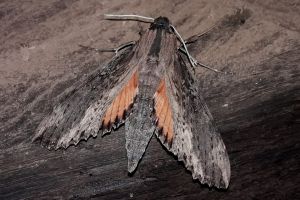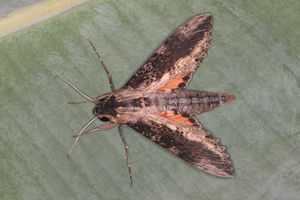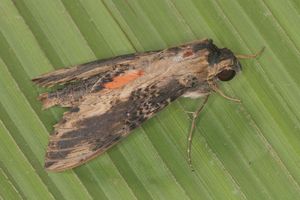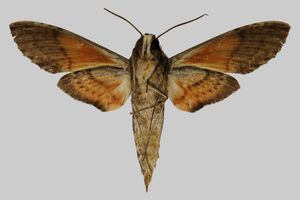

 +33Kontinente:EUNAMAKISA
+33Kontinente:EUNAMAKISA1. Lebendfotos
1.1. Falter
2. Diagnose
2.1. Männchen
2.2. Erstbeschreibung
3. Biologie
3.1. Nahrung der Raupe
- [Apocynaceae:] Tabernaemontana sp.
- [Apocynaceae:] Catharanthus roseus [= Vinca rosea] (Rosafarbene Catharanthe, Madagaskar-Immergrün, Rosafarbenes Zimmerimmergrün)
Die Raupe soll an verschiedenen Hundsgiftgewächsen (Apocynaceae) leben. Aus dem tropischen Südamerika wird mehrfach die Gattung Tabernaemontana angeführt.
[www7.inra.fr (abgefragt 18. Dezember 2021)] teilt mit: "Larva on Tabernaemontana spp. in Puerto-Rico and Brazil (Apocynaceae). Might live on T. citrifolia L. in the French Antilles (Pinchon)."
Auf [sphingidae.us (abgefragt 18. Dezember 2021)] ist zu erfahren: "This species feeds on plants in the Apocynaceae. It has been recorded on Periwinkle (Vinca rosea) in the USA and will accept this plant in captivity (2). This species can be found virtually anywhere on the plant, but may show a preference for new growth in the younger instars. This is an odd species, being found primarily in the mountains of Southeastern Arizona where it is dry and mountainous (2). It was also once established in California, where it fed on Periwinkle on the campus of University of California Riverside (2). Both of these habitats contrast greatly from the tropical forests it usually inhabits."
4. Weitere Informationen
4.1. Andere Kombinationen
- Dilophonota crameri Schaus, 1898 [Originalkombination]
4.2. Synonyme
- Erinnyis oenotrus Grote, 1865 [Synonym nach GBIF]
- Erinnyis omphaleae Butler, 1877 [Synonym nach GBIF]
4.3. Faunistik
Bereits in der Erstbeschreibung von Schaus (1898: 136) heißt es: "D. crameri is found throughout tropical America and also occurs in southern Florida."
Bei der [butterfliesandmoths.org (abgefragt 18. Dezember 2021)] heißt es zu Verbreitungsgebiet: "Paraguay north through Central America, Mexico, and the West Indies. Strays north to south Florida, South Texas, Arizona, and southern California."
[www7.inra.fr (abgefragt 18. Dezember 2021)] ergänzt: "Rare, in Guadeloupe and Martinique, in xerophilic zone. Marie-Galante. St-Lucia (Pinchon). Greater Antilles. From southern United States to Paraguay."
Aus Europa ist mir nur eine Meldung über ein in die Niederlande verschlepptes Exemplar bekannt geworden. Kuchlein & de Vos (1999: 135) schrieben dazu: "[5] A specimen of Erinnyis crameri (Schaus, 1898) was found in 1897 in Helden (province of Limburg) in a shipment of bananas from Colombia (C. Ottenheijm, i.l.)". Bisher gibt es keinerlei Hinweis auf eine erfolgte Etablierung - wenn, dann wäre eine solche in Europa am ehesten noch auf den Kanaren zu erwarten.
(Autor: Erwin Rennwald)
Nach [Global Biodiversity Information Facility] kommt die Art in Mexiko, Costa Rica, Brasilien, Argentinien, Dominikanische Republik, Venezuela, USA, Trinidad und Tobago, Kolumbien, Jamaika, Belize, Paraguay, Französisch-Guayana, Kuba, Honduras, El Salvador, Grenada, Haiti, Nicaragua, Peru, Guadeloupe, Martinique, Saint-Barthélemy, Ecuador, Panama, Bolivien, St. Vincent und die Grenadinen, Bonaire, Sint Eustatius und Saba, Guatemala, Guyana, St. Martin, Puerto Rico und Somalia [?] vor.
Locus typicus gemäß Erstbeschreibung: Tropical America.
(Autor: Michel Kettner)
4.4. Literatur
- Kuchlein, J.H. & R. de Vos (1999): Geannoteerde Naamlijst van de Nederlandse Vlinders - Annotated Checklist of the Dutch Lepidoptera. — 302 S.; Leiden (Backhuys Publishers)
- Erstbeschreibung: Schaus, W. (1898): Notes on American Sphingidae. — Entomological News 9 (6): 134-136. [Digitalisat auf archive.org]









































